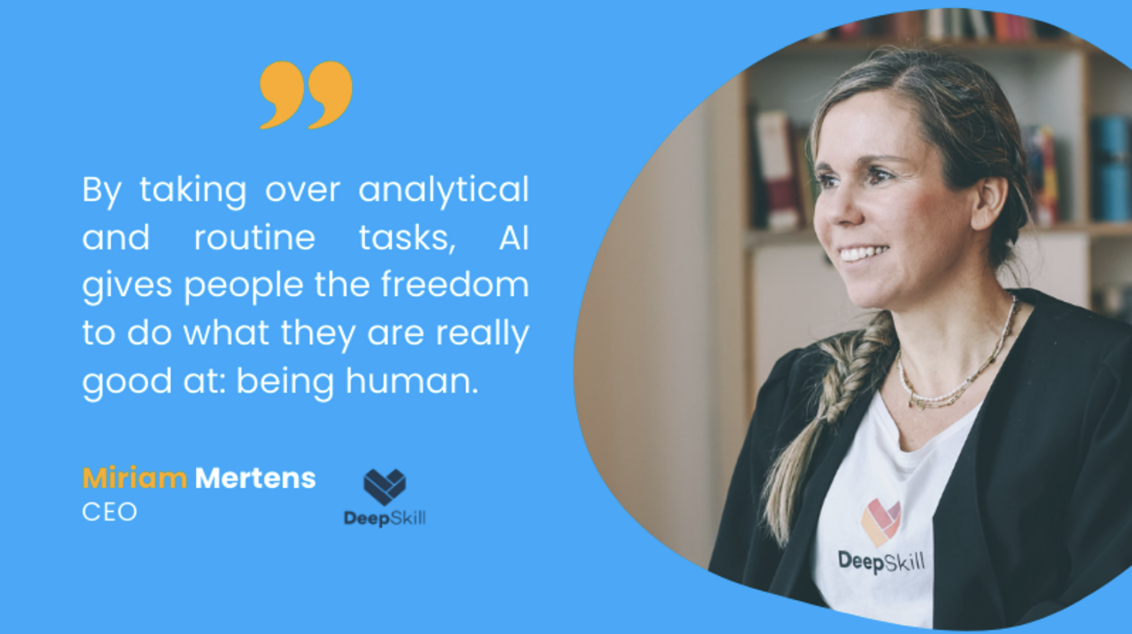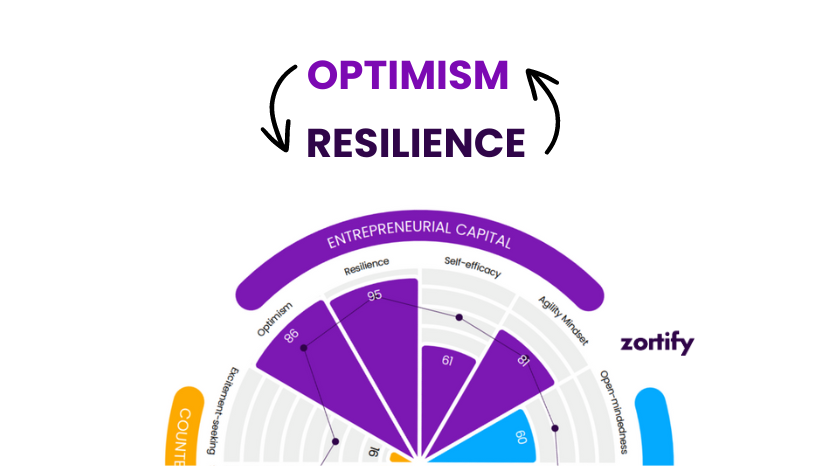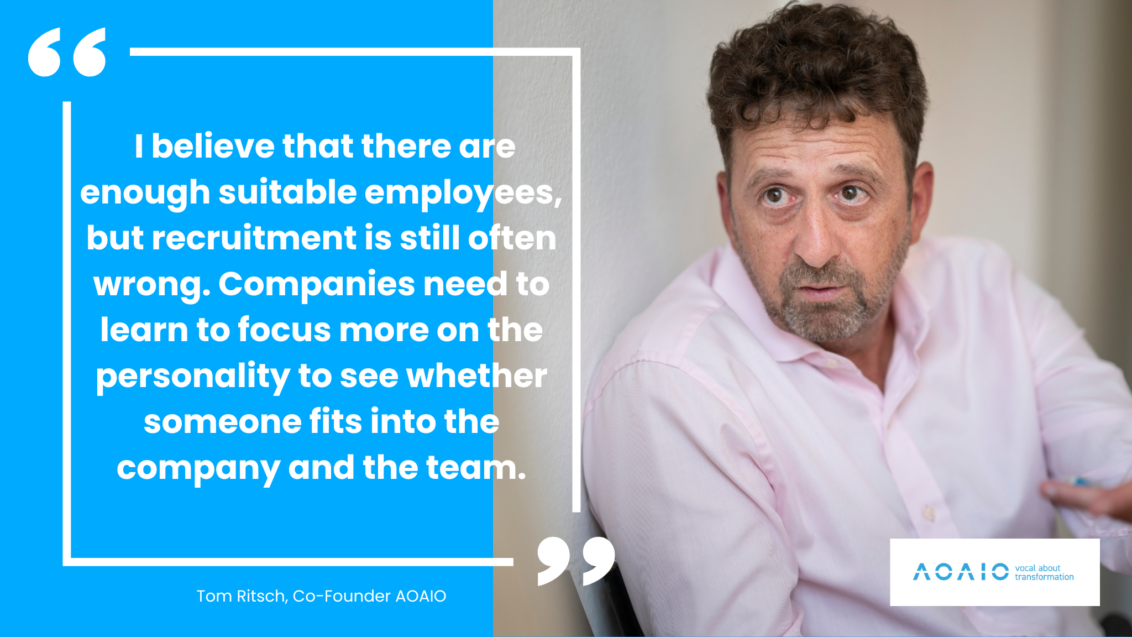“Humans are both the brain and the heart of organizations.”
Interview with Miriam Mertens, CEO of DeepSkill
Dear Miriam, AI as the brain and humans as the heart of an organization – is that what a bright future in companies will look like?
That would be a misconception: Humans are both the brain and the heart of organizations, and AI supports people in their work. AI is incredibly good at answering questions, but humans are much better at selecting the right questions. And implementing things with heart.
Looking at the comment sections on LinkedIn one can`t help but think that the human part is not developing very well. Is AI, in the end, the better, more empathetic leader that shapes company culture for the better? Is it the better brain and the better heart? Or, to put it differently: Do human qualities really become more important in the face of advancing technology, or are they really more of a hindrance on the path to a joyful, appreciative, and motivating work environment?
That impression can indeed arise – precisely because people don’t take enough time to focus on collaboration and building trust. Let’s take the feeling of appreciation as an example: Talking to my colleague or superior, feeling they really listen to me, pay attention, take my issues seriously and act on it – this is something AI will never be able to authentically generate.
AI can be extremely helpful in freeing up time so that we can take the time for exactly these kinds of conversations and interactions. By taking over analytical and routine tasks, it gives people the freedom to do what they are really good at: being human.
AI systems are already capable of making objective, analytically-based decisions, providing constructive feedback, coaching, and motivating. They are available 24/7 and neither have egos nor bad moods. So why do we still need human skills in companies, and which skills are those?
There are many abilities that AI can’t replace. For example, creating a feeling of appreciation, attention or affection. Conveying real deep meaning. And because only we humans have these skills, it is vital that we train our own workforce really well in them.
Let’s take the example of salespeople in the banking sector: nobody needs a human contact person in a bank to fill out a loan comparison portal and calculate the correct interest rates anymore. But when it comes to addressing people’s fears in a credit decision, reducing complexity for them, listening to their worries and needs or even empathizing with them to find out which criteria are really important for the credit decision, people’s emotional intelligence comes into play. Companies whose employees do not have these skills will have a very difficult time in the future.
How will recruiting and employee development change in the coming years?
Two trends are emerging: On the one hand, we are observing the ‘War for Talent’ on the labor market and. On the other, the trend towards a ‘Great Resignation’. Over the past two years, it has become clear that it is an employee market and no longer an employer market – the pool of talent has thinned. Companies that hide behind employer brand campaigns are quickly exposed if there is no corresponding corporate culture behind them. The expensively recruited candidates know their market value, take advantage of the oversupply of jobs and are more likely to resign.
When it comes to active sourcing, many recruiters are now approaching employees from other companies. It is therefore all the more important that there is a cultural fit so that employees are committed to the employer in the long term. To clear up a misunderstanding: this does not mean that employers have to do everything that employees demand. Rather, the aim is to create an attractive and modern working environment in order to retain employees. It has become more important to recognise the value of existing employees. Despite transformation changes, their wealth of knowledge and the experience they have gained within the company are precious.
With the help of employee development, existing employees can be supported in the process of transformation. Studies show that 80% of transformation projects usually fail because of the people, not the project itself. It is therefore important to involve employees in the process and not present them with a fait accompli.
At DeepSkill, you work with AI systems to promote the emotional skills of employees in organizations. How do you do that?
We call them ‘Deep Skills’, as our company name says. This is an overarching term for all skills that involve emotional and social competences. Skills such as emotion regulation, communication skills, changing perspectives and team development. Skills that employees need to be able to operate effectively in the modern, hybrid world of work. We have clustered these skills in our DeepSkill competency model. Allowing us to quickly and easily configure tailored coaching and training programmes.
AI helps us in different ways to make learning and the return on investment (ROI) of employee development significantly better. Firstly, AI enables the full personalization of learning materials, increasing the relevance of learning content for our learners and making learning much more effective. Secondly, we synchronize the company’s strategic goals with optimal learning paths, allowing for real behavioral change. This is also where Zortify comes into play: AI-supported diagnostics allow us to tailor learning content, formats, and intensity to each individual based on precise assessments. Off-the-shelf training is a thing of the past. Every learner receives exactly the right content and can develop in a targeted way based on their assessment results.
Employee diagnostics and personnel development are seen as the new super duo. They only work well if they go hand in hand. Would you agree to that?
Diagnostics makes it possible to identify employees’ areas of development and show in detail where their strengths lie. Which potential is still untapped and in which areas it is worth investing in further development. Personnel development is then the decisive lever for unlocking this potential. Without personnel development, the recognised areas of development cannot be fully exploited and the expected return on investment does not come about. At the same time, personnel development without prior diagnostics runs the risk of implementing measures in the dark and not addressing the relevant development needs. By combining diagnostics and personnel development, companies benefit in two ways: development needs are addressed in a targeted manner and potential is optimally utilized.
For more information about Deepskill check out their website and/or their LinkedIn account.
Did you know that DeepSkill received 1.5 million Euro funding last year? – Read more about the financing round and how DeepSkill is investing in innovative employee development technology in “Personalwirtschaft” magazine.
Prefer audio? – Then we recommend the interview with Miriam in SAATKORN‘s podcast.
You enjoyed the insight into the very practical use of AI in HR? You want more inspiration and hands-on tipps on how to start? – Check out the interview with Tom Ritsch, Co-Founder of AOAIO, and the interview with Dr. Hans W. Hagemann of Munich Leadership Group.
How to find and promote optimistic and resilient employees
Today’s working world puts the resilience and optimism of many people to the test. Digitalisation and automation require employees to regularly adapt to new technologies and working conditions. This calls not only for flexibility, but also emotional stability. According to the ‘State of the Global Workplace’ report by Gallup (2022), 44% of employees worldwide stated that they are under stress every day. Burnout rates continue to rise. A survey by the McKinsey Global Institute (2021) found that 42% of employees are concerned about workplace stress and its impact on their mental health. Added to this are the numerous global crises that are affecting people’s psychological well-being.
Those who are optimistic tend to be more resilient
We admit the numbers do not exactly scream “Feel positive!”. This makes it all the more important for companies to focus more on resilience and optimism as characteristics.
Resilience refers to the ability to overcome setbacks and difficult situations without falling apart. Resilient people always find the strength to recover and emerge stronger from crises. They remain focussed on their goals even in the face of difficulties and tend to learn from past experiences and use this knowledge to master future tasks.
Optimism, on the other hand, describes the ability to see challenges as opportunities for growth and further development. Optimistic people have a positive attitude that makes it easier for them to deal with obstacles. Through their optimistic view of the future, they can overcome fears and inspire others to take action, even those who may doubt or hesitate.
While these two characteristics are independent aspects they can also reinforce each other. In combination with a strong sense of self-efficacy, people with a positive attitude to life are more likely to trust in their ability to overcome problems, even in difficult situations. Studies show that optimistic people react more resiliently to stressful situations.
The positive consequences of positive thinking
Companies that specifically hire optimistic and resilient people benefit on several levels:
- Performance and productivity: resilient and optimistic employees remain productive even under pressure and overcome challenges more easily. They are more flexible and have a high frustration tolerance, which is an advantage in times of constant change. A study by McKinsey shows that companies that implement targeted resilience programmes achieve a 22% increase in employee satisfaction and productivity.
- Cost efficiency: Companies save costs in the long term, as employees with these characteristics are less likely to be absent due to illness and have a lower risk of developing burnout. According to a study by Deloitte, companies can reduce sick leave by up to 29% by implementing programmes to promote resilience.
- Innovative spirit: Optimistic employees see problems as challenges and develop creative solutions. A study by PwC shows that companies with more resilient teams are 1.5 times more likely to develop innovative products and solutions than companies with less resilient teams.
- Positive team dynamics: Teams made up of resilient and optimistic members are able to resolve conflicts better and work together more efficiently. These employees contribute to a positive working atmosphere that strengthens the entire team.
Finding optimistic and resilient employees with AI
AI can help companies recognise and promote optimism and resilience in (potential) employees in a number of ways. When recruiting, AI-supported systems can analyze application documents, social media profiles and work samples to find indications of resilience and optimism. AI-based personality diagnostics, like the ones we use at Zortify, are able to identify personality traits that indicate a high level of resilience or an optimistic attitude based on free-text answers to everyday questions. The risk of social desirability of answers is significantly reduced by AI.
AI-supported personality analyses can also make a difference when selecting and developing existing employees – especially when it comes to leadership positions. Optimism and resilience are important characteristics here. Hans Werner Hagemann from the Munich Leadership Group, one of our partner companies, has correctly stated that in the future, leadership must entail ‘shaking up’ employees in a controlled manner. In other words, making them insecure in their tried and tested behavioral patterns in order to push them out of their comfort zones without frightening them. This works best with an optimistic attitude, which prospective leaders already carry within them at best. AI can make it visible.
AI systems can also measure the mental state and well-being of employees by analyzing written texts and deriving automated reports and recommendations for leaders.
What to do with the less optimistic?
Of course, not all employees are optimistic or resilient by nature. However, this does not disqualify them for tasks with more responsibility or as team leaders. Firstly, it is important to identify the causes. These often lie in stress, overwork or personal problems. Managers should therefore be able to recognise warning signs and act appropriately. There are numerous programmes that help employees to strengthen their resilience, such as mindfulness training, stress management programmes and psychological counseling.
Optimism can also be trained. Neuroscientific findings show that regular positive thinking ‘reprogrammes’ the brain. Neuronal plasticity can create new thought patterns that lead to greater resilience and emotional stability in the long term. Methods such as journaling, cognitive restructuring or consciously focussing on positive events can help with this.
Creating a positive corporate culture
Companies must aim to establish a corporate culture that empowers employees. People who feel self-efficacy and trust in their abilities often find it easier to cope with changing conditions. An environment in which mistakes are not immediately punished, but instead result in a learning process, gives employees the confidence to get involved and try things out. Last but not least, companies should communicate that it is okay not to be okay sometimes, that crises are part of life and that employees are also seen as human beings with their fears and worries. A corporate culture that promotes optimism and resilience not only attracts new talent, but also helps to retain existing employees. A study by LinkedIn shows that 72% of professionals state that a positive work culture is a decisive factor when choosing their employer.
Round-up: Our top 5 ways to a resilient organization:
- Measuring optimism and resilience right from the recruitment stage. AI avoids social desirability.
- Provide coaching programmes to train resilience and optimism.
- Train managers in active listening.
- Accept mistakes and learn from them together.
- Continuously use AI-based personality diagnostics to visualise potential deficits, progress and development opportunities.
Hybrid work personality: The ‘person first’ approach and the role of AI
AI-based personality assessments can make a significant contribution to optimizing hybrid working environments. A recent survey found that 8 out of 10 employers have lost talent due to the obligation to return to the office, underlining the need for a balanced and personalized approach. ‘Person first’ as an extension of “people first”.
Recruit the curious!
“We run this company on questions, not answers.” This sentence comes from Eric Schmidt, Google’s former CEO. It makes it clear which characteristic the company values most in new employees: Curiosity. The recruiting strategy is correspondingly consistent: when the company was looking for engineers, it published a huge billboard with a riddle.
Good leadership: With self-reflection and unsympathetic filter
A good leader – is that something you are or is that something you become? – Let me put it this way: you are one if you are willing to become one. In other words, leadership requires a willingness to develop. Leading always means learning to lead. It is an ongoing process that is never finished, especially in the fast-paced world we live in.
Good leadership: With self-reflection and unsympathetic filter
by our CEO Florian Feltes
A good leader – is that something you are or is that something you become? – Let me put it this way: you are one if you are willing to become one. In other words, leadership requires a willingness to develop. Leading always means learning to lead. It is an ongoing process that is never finished, especially in the fast-paced world we live in.
I consider three spheres to be important in which leaders should continuously train themselves:
- reflection on my own current state,
- my own development process,
- the development process of those I lead.
These spheres do not necessarily build on each other. Rather, I am constantly moving between them, sometimes more in one, sometimes more in the other.
Leadership starts with myself
Let’s start with the first sphere, my own current state. Dealing with this usually becomes more urgent when things are not going well. When I notice that I keep falling into certain counterproductive behaviors, for example. Recently, a very interesting article was published in DIE ZEIT. It deals with the question of whether and how you can change your own personality or certain characteristics. The author refers to findings from psychotherapy research and thus to four essential steps for making changes to oneself:
- Awareness of goal and reality: Where do I (as a leader) want to go (goal) and what is currently holding me back (reality)?
- Awareness of my own feelings: What situations trigger what in me and why?
- Conscious “artificial” behavioral change: Practicing new behaviors, even if they don’t feel natural yet.
- Getting feedback from others: Ongoing reality check.
The common thread in this sphere is self-reflection. Knowing and leading yourself is the starting point for leading others well.
Resisting the temptation of linear thinking
The second sphere comprises my own development process as a leader in the sense of “leadership by doing”. Just like personal development, this process is also ongoing. It’s about consciously “taking the lead” again and again when the situation requires it. And, before and after that, moving within the organization and the outside world with a questioning and curious attitude:
- How are my employees, our customers, the competitors doing?
- What drives them?
- What can we do differently and better? Or rather: what could we do differently and better, as leaders should think big, have a vision in mind or be able to develop one.
To do this, it is helpful to keep broadening my perspective, to move in new contexts, to surround myself with people who do completely different things than me or the organization I work for.
I also train myself to recognize trends and patterns and am careful not to think too quickly in simple cause-and-effect relationships. Because the world is complex. And the flood of information and data sometimes doesn’t make it any easier. What helps is a systemic way of thinking that makes it possible to recognize the interplay of different dynamics and resist the temptation to think too linearly (X is the cause of Y and that’s it). This includes the willingness to realign myself in this system (what to keep doing, what to start doing, what to stop doing), to look at the system and my role in it from the outside and to search for new ways to make it work.
People and data skills
This in turn requires me to remain open to change. But also to take along those who have a completely different mindset than me. For me personally, the latter is one of the most challenging parts of leadership: actively engaging not only with those who are similar to me. But also and above all with employees who think and work very differently and have very different challenges than me. Good, unbiased data, generated with the help of artificial intelligence, can help here. This comes with another important leadership skill, though: Data competence. I.e. the ability to analytically and critically engage with data and derive the right conclusions from it. For example with regard to the individual potential and development of my employees. Which brings us to the third sphere: “actual leadership” in the sense of my leadership role in direct interaction with the people in the organization.
Leading and letting others lead
I keep asking myself when I, in my executive role, should actively take the lead and when it is better to let others take the lead. For me, this is the core of modern leadership. In which leadership is not based on a formal position, but rather unfolds situationally. In the face of the complex interplay of people, markets and global developments, the knowledge and experience of all employees is valuable for making good decisions.
Everyone can do or knows something that someone else cannot do or does not know. So anyone who wants to take responsibility for solving certain tasks and take the lead must be given the opportunity to do so. Decision-making power can vary depending on the task and project. It is no longer linked to the position, but to the competence for the current task to be solved. For example, a new employee can lead a project if he or she has the necessary know-how. While the senior manager only assists in this project.
Leadership Culture
This requires a leadership culture in which people have the confidence to take the lead if, for example, they notice negative developments in the organization or a project is set up that requires their expertise. Such a culture is created above all by an empathetic, well-informed leader who is capable of reflection (see spheres 1 and 2). Their goal should be to make themselves as dispensable as possible in day-to-day operations. This requires employees to know the framework in which they operate and the degree of freedom for situational leadership within this framework. As a leader, I need to decide where to define hard criteria that give employees guidance when making decisions. And where it is possible to leave decisions open so that employees can negotiate things with each other and individual team members can take the lead themselves.
Thank you, unsympathetic filter.
Stimulating and supporting these processes is also important in order to bring up a new generation of leaders who can develop further in the three spheres mentioned. Employees who are particularly well suited to executive roles due to their personality traits can be identified during the application process with the help of smart AI technology. At the same time, AI generated data helps to ensure that people with toxic behaviors, who according to my experience are neither interested in self-reflection nor have great empathy or special interest in the strengths, wishes and abilities of their colleagues, fall off the grid at an early stage. Technology with a built-in “unsympathetic filter” for sure will not make the perfect executive team by magic. But it does make a significant contribution to ensuring that the right people can start to become leaders at the right time.
Empowered teams: doing the right thing (instead of doing everything right)
What is more important on the job – doing things right or doing the right things? – Most people will probably answer “both”. Nevertheless, in the context of changing corporate cultures, it is worth thinking about this question in its absolute either-or variant.
Recruit the curious!
“We run this company on questions, not answers.” This sentence comes from Eric Schmidt, Google’s former CEO. It makes it clear which characteristic the company values most in new employees: Curiosity. The recruiting strategy is correspondingly consistent: when the company was looking for engineers, it published a huge billboard with a riddle.
The self-made skills shortage
Why should we analyze applicants in depth if we have no choice about who we hire anyway? We hear this question a lot. It reflects the frustration many companies feel about the lack of skilled workers. And rightly so? – We say: Yes and no. For one thing, we think that the shortage of skilled workers is not a “force of nature” that companies are helplessly exposed to.
Empowered teams: doing the right thing
(instead of doing everything right)
What is more important on the job – doing things right or doing the right things? – Most people will probably answer “both”. Nevertheless, in the context of changing corporate cultures, it is worth thinking about this question in its absolute either-or variant. For a long time, companies were primarily concerned with doing things right. To put it simply: Always work through what has been ordered and don’t make any mistakes. In the world we live in today, this approach no longer works very well. In the face of a rapidly changing environment, companies are constantly having to decide what is the right thing to do. Even at the risk of making mistakes.
Stronger in a swarm
To do this, they need teams that can dynamically align their working methods and roles with what needs to be done, using their collective strengths and insights. Because one thing is clear: No one can solve the complex challenges of our time alone. No one, not even the person with the most impressive job title, can always know which path is the right one. This requires the senses, experience, insights and skills of many people.
But what is the best way to bring these to the table?
When we talk about the transformation of companies and the associated cultural change, it is usually about giving more authority and responsibility to individual employees. However, this is only one aspect of team empowerment. Before that, the focus should be on what the individual can and wants to contribute to the team. Employees’ knowledge, talents, skills and competencies do not have the same quality and relevance at all times and for every task. Take “knowledge”, for example. This is considered a valuable skill in the knowledge society. But how valuable is knowledge that cannot be translated into concrete action? Knowledge without knowing how to bring it into the team in a meaningful way is useless for companies.
Banal yet ingenious: measuring preferences and strengths
What companies need today are employees who want to actively shape the world around them with what they are really good at. And who can translate their knowledge and skills into meaningful action in collaboration with others. How well and how quickly transformation takes place. And whether companies manage to change in the long term depends on the skills of each and every individual. And the skills of teams as engines in companies.
For these engines to run well, the individual parts must be anchored in the company with the right tools. We have developed the so-called “Preferred Performance Contributors” (PPCs) as effective tools. PPCs represent a new, innovative approach to team dynamics. In contrast to traditional management tools and personality assessments, which often promote generic roles and stereotypes, they focus on the natural inclinations and individual strengths of team members. They help to identify specific preferences through which employees prefer to contribute best to team success.
We have identified six areas of preference:
- Vision & Ideation
- Networking & Promotion
- Creation & Prototyping
- Structuring & Facilitation
- Analysis & Criticism
- Scaling & Production
The individual PPCs are determined in three ways:
- Through a self-assessment by the employee: How do I want to contribute?
- (optional) through peer feedback from colleagues: Where did you perceive me particularly strongly?
- through an AI-based personality test specially developed by us: From what I know about you, the following preferences are likely.
The AI test uses an algorithm that extracts relevant personality traits from answers to open text questions. And creates an AI-supported prediction of the PPCs.
The result of the analysis is a ranking of the six PPCs for each employee. It is important to emphasize that all contributions are in principle equally valuable. For companies, it is important that they can play out the right preferences in the right combination at the right time.
An example from one of our customers, a large software company: The team wondered why they never managed to meet deadlines. Many products were far from market-ready. Instead, they kept developing new features with great enthusiasm and energy. The analysis finally shed light on the situation. As it showed that the PPCs “Scaling and Production” were not among the top 2 preferences for any of the team members. “Creation & Prototyping”, on the other hand, were strongly favored. This gave the team a basis for rethinking tasks and roles so that they can bring products to market on time in the future.
In principle, employees can meet all preferences, but depending on their personality type, one may suit them more than the other. Intuitively, we probably tend to want to expand our strongest preferences with additional skills and experience. At the same time, it can be exciting (or necessary) to delve into the less obvious areas of preference. Either way, the analysis provides a good basis for discussing individual preferences and strengths with colleagues and positioning the team well for upcoming tasks. A nice side effect: psychological safety and the feedback culture in the team are also strengthened.
World in motion – teams in motion
PPCs empower teams to constantly redistribute roles and responsibilities in order to do the right thing and avoid major mistakes. A reorganization can result, for example, from new external conditions or from changing preferences among the team members themselves. This is because skills and preferences change over time and depending on the phase of life. For example, an employee who has always been a gifted networker in the forefront but suddenly has to care for a relative may want to focus more on providing structure and support in the background. Or they may want to take on a role that perhaps does not match their previous PPCs at first glance. But which they can fill well in their current situation with appropriate further training.
Perhaps the results of the AI analysis (in which desired answers have little chance) will inspire them to look at possible new roles. That they have not yet considered based on their self-assessment and colleague feedback (both of which tend to fall into certain patterns).
The example shows very nicely that PPCs are not fixed attributions. But primarily promote dialog and awareness in teams and ensure that employees do not wither away in their silos, but can become as effective as possible. And that from day one in the company. If new employees are familiar with their preferences and role expectations, they can reach their full potential more quickly. PPCs turn them from pure skill owners into skill users and ultimately – ideally – into drivers of change and transformation, driven by the need to do the right thing. Even at the risk of not always doing everything right.
A good team can handle that.
HR should focus far more on personalities!
Personality first – this is one of the most important trends in dealing with talent.
Why? The so-called “hard” skills that companies need are changing faster than ever before. Today’s expert skills will be yesterday’s news tomorrow. What remains are the supposedly “soft” skills and people’s personalities. The better companies know their employees, the better they can…
Recruit the curious!
“We run this company on questions, not answers.” This sentence comes from Eric Schmidt, Google’s former CEO. It makes it clear which characteristic the company values most in new employees: Curiosity. The recruiting strategy is correspondingly consistent: when the company was looking for engineers, it published a huge billboard with a riddle.
The self-made skills shortage
Why should we analyze applicants in depth if we have no choice about who we hire anyway? We hear this question a lot. It reflects the frustration many companies feel about the lack of skilled workers. And rightly so? – We say: Yes and no. For one thing, we think that the shortage of skilled workers is not a “force of nature” that companies are helplessly exposed to.
The self-made skills shortage
– and how companies can overcome it
Why should we analyze applicants in depth if we have no choice about who we hire anyway?
We hear this question a lot. It reflects the frustration many companies feel about the lack of skilled workers. And rightly so? We say: Yes and no. For one thing, we think that the shortage of skilled workers is not a “force of nature” that companies are helplessly exposed to. And secondly, we are certain that in many areas there is no real shortage. But rather an onboarding and “distribution problem”. We are convinced that companies can do a good job even with a shrinking talent pool if they
- set their recruiting priorities differently,
- tailor the onboarding of new employees precisely to them,
- focus more on the potential of their existing employees.
To do this, they need good data beyond the CV.
Personality determines performance
Both when recruiting new employees and when assigning existing employees, we believe it is important not to rely on first impressions. Instead, the HR department can use AI-supported analysis methods. To identify personality traits that are difficult to recognize even at second glance. But which contribute significantly to whether employees really have the desired impact. This depends less on the requirements formulated in a static job advertisement. And more on what makes a person tick and whether they have certain character traits. Such as a desire to learn, openness to new topics and social skills. Many technical skills can then be learned on the job.
Promote horizontal career development
Not every new job has to be filled by recruiting from outside. Instead of the traditional vertical career ladder, horizontal development paths are gaining in importance. This means that employees are no longer necessarily aiming for the next higher position. But want to look left and right within the company. Gain new experiences and take on responsibility outside of their previous working routine. This is possible, for example, by working on projects. Or in the course of so-called “short assignments”. These are short-term tasks that often only require a very specific skill set to be combined in one or two people max. A tangible example of such a short assignment is the creation of a digitalization concept – a task that is likely to be at the top of the agenda for many companies right now.
In an interview with Tom Ritsch, co-founder of the transformation consultancy AOAIO, which you can find linked below, he emphasizes that in future, hire-on-demand approaches and therefore the human fit will become much more important for companies than fixed skills. Project teams are increasingly being put together like teams in team sports, where each player has an assigned role. The captain’s armband is worn by whoever has the right personality to motivate the team and keep it together. The advantage of these changing team constellations and horizontal career development in general is that employees acquire a wide range of skills that the company can tap into again and again as required.
Agile employees – (im)agile companies?
In order to tackle the supposed shortage of skilled workers, it makes sense for companies to consider recruiting and learning & development much more holistically than before and develop a comprehensive “mobility concept” for talent. In this context, US HR expert Josh Bersin has identified three directions of talent movement that good HR work should focus on:
- that of new employees into the company,
- that of existing employees within the company and
- former employees returning to the company (so-called “boomerang employees”).
Two of these groups – existing and former employees – are already familiar with the company’s culture and products and, at best, have also proven themselves professionally. On the basis of AI-supported employee diagnostics, which analyze the personality of individuals with a focus on their entrepreneurial potential, for example, these employees can be (re)recruited for new tasks and challenges in a targeted manner. At the same time, such an analysis gives companies a certain degree of assurance that new applicants. Even if they are not a perfect fit for a position from a professional perspective, have character traits that can be built upon. And that they will not bring any foreseeable toxic behavior into the company. If these criteria are met, employees can be qualified for their new role step by step with good onboarding and individually tailored L&D programs.
Shine on the inside, sparkle on the outside
Companies that invest in personality-based learning & development and thus support the internal mobility of their workforce can also have a positive impact on external recruiting. How can they do this?
Promote diversity:
By suggesting suitable roles and positions to employees based on an unbiased personality analysis, the foundation is laid for diversity and variety in the staffing of teams. Diverse positions and a high degree of equal opportunities within the company in turn attract talent from outside.
Avoid employee turnover:
When employees have the opportunity to develop within the company. And pursue new career paths on their own initiative, they stay longer. According to the “2021 State of Internal Recruiting Report” by Smart Recruiters, high-performing employees are 20 percent more likely to stay with the company if they can change their role or sphere of influence if necessary. Low staff turnover, in turn, has a positive effect on the employer brand. And thus the external perception of the company by applicants. Tom Ritsch from AOAIO takes a similar view. Even if it seems that the company cannot find suitable employees. It should continuously work on positioning itself on the market for existing and potential employees, says Tom. (You can read the whole interview here).
Improve the candidate experience:
If companies take an increasingly situational approach to filling roles and positions internally and enable their employees to develop horizontally as they wish. For example as part of projects and short assignments. There is a good chance that this will also rub off on external recruitment practices. In other words, here too, HR may focus more on the essentials. On characteristics and skills that are really needed at the moment. Instead of using static requirement profiles as a benchmark and thus drawing attention to deficits. Recruiters talk to candidates and focus more on qualities. Such as willingness to learn, creativity and enjoying taking over responsibility.
Yes, you can.
There are many great real-life examples that show that companies that embrace new learning and career paths and make people’s personalities their compass are more resilient in the face of the skills shortage:
- VW has abolished standardized training in technical professions. Instead, trainees teach themselves what they need to learn in an open experimentation room.
- Kuhn Elektro Technik GmbH, one of the largest specialist companies in the industry in Munich, takes on long-term unemployed people, even those without the relevant training or previous experience. The main requirement is that they have the right personality. A success story that is looking for imitators.
- The IT consultancy Viadee is one of the most popular employers in Germany. This is also because it constantly keeps an eye on the needs, wishes and limits of its employees. In addition, every employee has a mentor from the HR department at their side.
So companies certainly do have a choice. Namely, whether or not they are willing to self-critically question their previous recruitment practices and face up to the new realities with maximum openness and the support of smart technology.
HR should focus far more on personalities!
Personality first – this is one of the most important trends in dealing with talent.
Why? The so-called “hard” skills that companies need are changing faster than ever before. Today’s expert skills will be yesterday’s news tomorrow. What remains are the supposedly “soft” skills and people’s personalities. The better companies know their employees, the better they can…
Recruit the curious!
“We run this company on questions, not answers.” This sentence comes from Eric Schmidt, Google’s former CEO. It makes it clear which characteristic the company values most in new employees: Curiosity. The recruiting strategy is correspondingly consistent: when the company was looking for engineers, it published a huge billboard with a riddle.
Measuring the GenZ: Lost in translation is so 2003
“Too leisure-oriented? – We’re just hard-working in a different way.” was the headline of the brandeins magazine in September 2020, using many examples to draw a picture of a Generation Z that is changing the world of work practically “on the job”. The new generation of employees is neither lazy nor inherently less well educated than previous generations, , even if they are repeatedly accused of being so.
“We are not looking for consultants, we are looking for people who fit in well with us.”
Tom Ritsch, Co-Founder of AOAIO
“We are not looking for consultants, we are looking for people who fit in well with us.” – Interview with Tom Ritsch, Co-Founder of AOAIO
Hi Tom, this week we’re looking at the question of why companies should even bother assessing candidates in depth if they don’t have much choice anyway. What would be your spontaneous answer to companies that think this way?
This is probably more about internal and external employer branding. Even if it seems that you can’t find suitable employees, this is exactly what you should be focusing on. Companies must always work on positioning themselves on the market for existing and potential employees. Employer marketing is the key to sustainable success here.
When it comes to the skills shortage, we see different perspectives: some say the shortage is real, while others believe that there are enough people to do the job, but the antiquated structures in companies prevent them from working efficiently. Partly because they are not working in the positions or roles that suit them. Do you share one of these perspectives or do you have your own?
The shortage is partly real, but often a good excuse. In my opinion, it’s about doing an excellent job at all levels. Yes, I also believe that there are enough suitable employees (as always, exceptions prove the rule), but recruitment is still often wrong. Companies need to learn to focus more on the personality to see whether someone fits into the company and the team. Of course, if someone needs certain skills for the job – languages, programming, finance, etc. – they have to have them. But for me, the focus is on the person and the fit. At AOAIO, for example, we are not looking for consultants, we are looking for people who fit in well with us and who I would take with me to the customer any time. You can learn a lot in our job, but empathy and social skills must be there, as well as entrepreneurial potential. So I agree with the statement that it is outdated structures that prevent us from finding suitable employees. In the first place, companies are still searching as they did 20 years ago (it’s a miracle that they don’t still advertise in newspapers) and secondly, the processes and requirements are no longer up to date.
At AOAIO, you support companies in transformation processes. What challenges do these companies share and what differences are there, perhaps with regard to different industries?
What all companies share is the great challenge of digitalization and optimization and the enormous speed that is required. In contrast to the financial industry, where the message has gotten through, industrial companies in the SME sector are struggling enormously with these changes and the necessary investments. The core problem is still that the companies are doing well, perhaps too well, and therefore do not yet see the need for change. There are often people at the top who grew up in a different era and function differently, which is very dangerous for these companies. But often the core problem is that they do not know how to proceed. Who can I trust to do what is really important and necessary? Who understands my needs and who just wants to sell me software. This is something we often struggle with, or come up against when the wrong decisions have already been made. The digitization requirements are actually the cause, because instead of looking at the topic holistically – why do we need what exactly at what point and how does this help us to become more successful (digital roadmap approach) – individual processes are backed up with new software and thus adjusted. The process is rarely considered end-to-end and the customer perspective is all too often overlooked. The result: frustrated employees, dissatisfied customers, bad investments. That’s why I love to show the basic formula of digitalization:
OP + NT = EOP → Old Processes + New Technology = Expensive Old Processes
This means in one sentence: With all the digitization hype, one must not forget that the processes have to be adapted!
As a consultant you are specialized in “human transformation” in an organizational context. From your perspective, do the organizations need to change or the people?
That’s an interesting question. First of all, it’s up to the managers. Just because you read a book about New Work during the vacations doesn’t mean the organization will change. Organizational development has become a core issue and this includes taking people with you, involving them and giving them more responsibility. However, this does not happen overnight, it is a process. It always starts with self-reflection. So the answer is: everyone has to change and be prepared to do so.
How do organizations find the people who are right for them?
To do this, organizations first need to know who they are. What is the culture of the organization, what values are being lived and what makes it special? It is essential to reflect on the company. Just because values are written somewhere on the wall does not mean that they are actually being practiced. A cultural analysis or simply a suitable employee survey helps enormously. If it is clear what makes you tick you can look for suitable people on the market and place your messages in line with the target groups. Of course, for larger companies this can mean having several structures and approaching the market with a variety of approaches in order to position themselves. I address construction workers differently than HR employees.
Looking at the younger generation: How have career requirements changed and how can companies adapt to this?
I don’t quite know if I’m the right person to answer that. There are specialized companies set up by young people to answer these questions for established companies. I personally believe that it has changed massively and will continue to do so. I think it will move more towards a hire-on-demand-concept, which will make the human fit even more important. Project teams will be organized like you select the right players for a specific task in team sports. Careers are becoming less and less relevant and companies have to develop such New Work concepts. It’s not about a nice workplace with table football and a juice bar. It’s about concepts that are contemporary and meet all needs. But here, too, the first step is self-reflection: What does the company need in order to be successful? It always comes down to these three central questions:
- Where to play?
- Who is in the team?
- How to win?
What role does AI technology currently play in transformation processes and what role do you think it will play in the future?
A huge role! However, companies must first learn to understand what this hype is all about and where the benefits are significant. We successfully use Zortify’s AI based tools in our projects because we put people at the center of things and not simply rely on a self-assessment based on the Big 5. Those days are definitely over. Let’s use AI where it makes sense. It’s not so much about finding out who is right and who is wrong, it’s about helping people to improve.
You have just mentioned that you and your colleagues use Zortify’s employee diagnostics for your consulting. Can you give some examples of how you work with it? Perhaps you even have an anecdote about what you were able to recognize or achieve with the help of AI?
At the beginning of our transformation processes (SharedWhy), we primarily rely on Zortify GROW. This gives us very good insights into the teams and provides us with a perfect basis for reflection. We also often use iHPT (instant High Performance teamingg) in various areas. The central issue here is the perfect composition of teams. We work very closely with Zortify on this topic in order to develop it further as we believe there is enormous potential there. Especially with the iHPT process we are always amazed at how easy it is to get management to really think about it. These reports trigger excellent discussions, which often circle around the impact and role in the team. Suddenly questions arise such as:
- Hmmm, am I actually the right person on the management board to address the employees just because I’m CEO? Or is there someone in our team who is better at talking to employees?
Or
- Should we as managers communicate this change of mindset to our employees in order to act as role models?
Thank you so much for the insights. We have one last question for you: In the past you have founded a start-up in the sports sector. Imagine you’re standing on the sidelines of the field cheering for a prototypical SME in the “game for the future” – what do you shout to them?
That’s a bit difficult in the sport I’m involved in. First of all, there’s no sideline in golf and shouting isn’t really the issue. 🙂 Joking aside. I do the same as I do with the players I still coach and often use these metaphors in the business world:
- Your success doesn’t depend on this one action; think and act long term.
- Create a team of people you trust (internally and externally) and decide together.
- You train to be OK on a bad day, not to excel on a good day.
Thank you for the interview, Tom.
For more information about Tom and his work at AOAIO check out their website or follow Tom on LinkedIn.
“We run this company on questions, not answers.” This sentence comes from Eric Schmidt, Google’s former CEO. It makes it clear which characteristic the company values most in new employees: Curiosity. The recruiting strategy is correspondingly consistent: when the company was looking for engineers, it published a huge billboard with a riddle. Anyone who solved it ended up on a website and thus in the selection process of Google’s HR department. And that’s regardless of the puzzle solver’s formal qualifications for the open position.
Is curiosity the super skill?
Curiosity is not actually a skill, but a tendency towards certain behaviors. Curious people embrace the unknown, have the courage to try things out and enjoy taking the first steps on a new path. Our research shows that this is closely linked to characteristics that are attributed to a person’s “entrepreneurial capital”, such as the “agility mindset” personality trait. People with a strong agility mindset approach the challenges of a fast-paced world with a strong creative drive. And see themselves as capable and willing to influence the developments around them. This characteristic can be trained, as you will see in the second part of the article.
With this in mind, curious personalities can be a huge asset to companies. After all, our environment and the conditions under which organizations have to operate have been changing at an ever-increasing pace for years. People who have a natural curiosity are usually better able to deal with these changes and are more open to new situations and insights. Even for those that contradict their previous beliefs. There is unlikely to be a “We’ve always done it this way” with them in the team.
Instead, they constantly question the status quo. Like to explore new ways of overcoming challenges. And are not so quick to settle for the first solution that comes along. Their strong interest in new things also relates to other people, which tends to make them good team players. Even in very heterogeneous constellations. Anyone focusing on diversity when recruiting is therefore well advised to look at how well developed characteristics associated with curiosity are in candidates.
Mister & Miss T
Because these often go hand in hand with other valuable character traits and skills. The so-called “T-Shaped Employee” is the jackpot among employees. On the vertical axis, the stem of the T so to speak, he or she brings in-depth skills in at least one area, for example in marketing or finance. The horizontal bar of the T stands for overarching characteristics and soft skills. People with a keen interest in new things, for example, also tend to have a great capacity for empathy and the ability to collaborate. While expert knowledge can be read off the resume from the stem, other measurement methods are needed for the horizontal axis.
In the past, these were mainly costly assessment centers in which attempts were made to find out what makes candidates tick using fairly straightforward personality tests. Thanks to AI technology, there are now more sophisticated methods that use natural language analysis to measure character traits. Subtle and unbiased.
Putting the brakes on curiosity – here’s how
Although curiosity plays an important role in meeting new challenges, it is not yet sufficiently valued and encouraged in companies. The practice of trying to solve problems of the present and future with resources from the past instead of courageously asking the right questions persists. In a 2021 SAS study, one in five German managers rated curiosity as an unimportant trait for company performance.
(five percent more than the international average)
This result leads directly to one of the biggest obstacles to more curiosity in the company: The way performance or success is measured. KPIs that are too tough not only cause unhealthy stress among employees, but also put the brakes on their curiosity. Those who have neither the time nor the energy to ask themselves questions simply carry on as before. Regardless of whether it makes sense or not. Two points speak against this way of working:
- Companies that focus too much on human efficiency sometimes lose sight of what matters: their customers. Their needs are changing. Their needs must be observed, questioned, analyzed and translated into meaningful business strategies and products.
- With the help of technology, efficiency gains are possible without people getting caught in the hamster wheel. When used correctly, AI tools, for example, relieve employees to such an extent that they can curiously search for innovative ideas.
Instead of measuring success solely in terms of performance and KPIs, companies can focus more on learning goals:
- What situation were we able to handle well?
- How have we improved?
- What new skills did employees XYZ acquire?
Learning to think small
In my opinion, the learning organization is the model with the best prospects for the future. And curiosity is an essential part of future competence in organizations. This is based on the insight that we cannot plan the future. Models and strategies that try to predict what the company will need in five years’ time are outdated. Instead, companies need to strengthen the self-efficacy of their employees and learn to trust in the process.
“Instead of thinking big once, it’s about thinking small very often in order to achieve great things,” writes Martin Wiens in Neue Narrative magazine (issue #3). Among other things, he refers to management researcher Jim Collins, who investigated what particularly successful entrepreneurs do differently to others. One key factor: they are curious. He calls it “paranoid in a productive way”. In other words, they constantly engage with their environment, the market and their organization. Even and especially when things are going well. At the same time, they encourage their employees to keep their eyes and ears open, ask themselves critical questions and become effective in the best interests of the organization.
Training curiosity
“I have no special talent, I am just passionately curious,” said Albert Einstein. – The good news is that everyone is born with a minimum level of curiosity. Otherwise we would not have learned to speak or walk. It is usually the structures in which we operate. From nursery school to the company office – that allow this valuable quality to wither away. It is up to managers to restore it. For example, with these three simple workhacks:
#1 The customer chair
In physical meetings, this is a chair at the meeting table that is left empty to remind participants to always think from the customer’s perspective:
What would our customer say about this if he or she were in the room?
What would he or she think of the idea?
And, what impact would our decision have on the customer?
In virtual meetings, a team member can slip into the customer role and actively answer the above questions from the customer’s perspective. To make the role visible to everyone, the colleague can wear a hat or a large sign with the customer’s name, for example.
#2 The learning journey
… consists of a single question from HR or managers to employees: Imagine we give you three tickets for your personal learning journey. With these three tickets you have access to everything (e.g. countries, companies, the Chancellor’s office, NASA, prominent role models, a farm in the hinterland, …). Where would you stop along the way to learn something or to look behind the scenes (simply out of curiosity)?
The answer can be short and concise and does not have to be justified. While some stops on the learning journey directly indicate specific interests, others form a basis for engaging in conversation with employees and getting to know the other person better.
#3 Slack Time
Slack time is a fixed period of time each month during which employees can work on or try out their own ideas. This time can be made available to either one department or the entire company. The only requirement is that the project is related to the company’s goal. Employees briefly present what they have been working on at regular intervals. A message board can serve as an additional tool on which colleagues can note which projects they (would like to) work on so that teams can find each other in a self-organized manner. Slack Time helps to find useful product ideas and solutions to organizational problems for which there is sometimes no time in everyday work.
Companies do not need to have ready-made answers to climate change, demographics, dealing with global conflicts, skill gaps, GenZ, GenAlpha and the AI revolution in order to manage change and, at best, help shape it. But they should start asking themselves the right questions and allow themselves to be as curious as ever.
HR should focus far more on personalities!
Personality first – this is one of the most important trends in dealing with talent.
Why? The so-called “hard” skills that companies need are changing faster than ever before. Today’s expert skills will be yesterday’s news tomorrow. What remains are the supposedly “soft” skills and people’s personalities. The better companies know their employees, the better they can…
Employee diagnostics: What do you care about my personality?
How much “humanity” is good for organizations would be answered very differently by people from different philosophies. On the one hand, there are those who say that we can only do good work if we are allowed to be ourselves in a professional context, with the full range of our characteristics, feelings and needs. This view has become very popular with the New Work movement.
Measuring the GenZ: Lost in translation is so 2003
“Too leisure-oriented? – We’re just hard-working in a different way.” was the headline of the brandeins magazine in September 2020, using many examples to draw a picture of a Generation Z that is changing the world of work practically “on the job”. The new generation of employees is neither lazy nor inherently less well educated than previous generations, , even if they are repeatedly accused of being so.
Less CV, More Me.
Less CV, More Me.
Why HR needs to focus much more on personality
Personality first – this is one of the most important trends in dealing with talent.
Why?
The so-called “hard” skills that companies need are changing faster than ever before. Today’s expert skills will be yesterday’s news tomorrow. What remains are the supposedly “soft” skills and people’s personalities. The better companies know their employees, the better they can assess who they should invest in in terms of professional and personal development.
Bye Bye Bachelor
But an engineer still needs to be familiar with physical principles; an architect needs to know material features, how to use drawing programs and what regulations to take into account. – That is true. Expert knowledge is essential in some professions. For many jobs, however, a different trend has been emerging for a long time. While German HR departments cling surprisingly persistently to university degrees in their job postings, companies in other countries have long since abandoned them. According to a study published in the Harvard Business Review in 2022, US companies reduced the requirement for a university degree by 31 percent when advertising positions with a high level of qualifications, including management positions.
The British branches of Ernst & Young announced ten years ago that a university degree would be completely removed from the job profile. This is in line with numerous studies that were recently listed in a very interesting article on t3n. It clearly shows that soft skills will be much more important in the future. And that goes for engineers and architects too, by the way. After all, they are also involved in an increasingly complex environment that is subject to constant change. And in project work that is carried out by multidisciplinary teams. And in companies that are under increasing pressure to transform their structures from the ground up while day-to-day business must continue.
Transformation needs personality
These companies (and sooner or later it will affect almost all businesses) need employees who are willing to develop with them. It is becoming increasingly important to entrust people with the right role in the company at the right time, in which they can access and contribute their full potential. Certain character traits are even more important in that regard than professional qualifications or a formal degree.
Why?
Because transformation means that the traditional hierarchy is increasingly dissolving. And with it the logic of the commander and the recipient of orders. This leads to consequences:
1. Without top-down instructions, interaction between employees who are on the same organizational level becomes the most important steering element in companies. In the book “The Humanization of the Organization”, the authors write in this context: “This brings with it all kinds of annoyances – self-promotion, refusal to make a statement due to stage fright, tactful agreement to nonsense, (…). Anyone who frequently has to endure fruitless meetings that largely serve the self-promotional needs of some of the participants (…) knows the problem.”
2. In structures where individuals have more responsibility and cannot refer to their superiors every time they have a dispute with a colleague, the ability to deal with conflict and self-control are essential. The ability to win others over and mediate between subjective realities takes the place of punishment and reward or right and wrong.
3. Having the freedom to shape things in your own way also means making decisions under uncertainty. This requires a stable personality and at the same time the right instinct for situations and the ability to get the right people on board.
The best basis for coping with these new conditions are employees who have certain personality traits (or: who do not have them – see excessive tendency towards self-promotion) and with them certain soft skills at a high level. At the very least, however, personality is a good starting point for acquiring these skills. Sebastian Klein writes in the magazine Neue Narrative (issue #19): “People who resist any kind of personal development and reject personal responsibility cannot play a leading role in an organization that is fundamentally changing its operating system.”
More automation – more soft skills
An operating system that must change not only in view of the demands of a new generation of employees, but also in view of increasing automation. Many jobs will change, moving away from purely mechanical activities towards mediating, translating and explaining work at the interface of machines and interdisciplinary teams. Personality and soft skills will be the decisive factors in workforce planning and in the design of individual learning and development programs.
So which character traits are the most important? Which soft skills will be even more important in the future? – There are various rankings on this, such as LinkedIn’s Top Skills 2024, which also clearly shows that the supposedly soft factors are gaining in importance.
The “Inner Development Goals” framework is also worth a look. This has derived various dimensions from the question of how we can create a sustainable and liveable future and assigned the essential skills and attitudes to them.
If you put the various rankings and frameworks side by side, including the models we use at Zortify to analyse the personality of employees and applicants, a very clear picture emerges of where the journey is heading, even if individual nuances will vary from organization to organization.
Our top 3 personality traits…
… and the corresponding soft skills are:
1. High level of open-mindedness
People with a high degree of openness are generally curious, tend to question the status quo and enjoy exploring new ideas and opportunities.
Corresponding soft skills: listening, exploring new topics, taking initiative
2. Moderate agreeableness combined with moderate competitiveness
Individuals obtaining moderate scores on the Agreeableness – Competitiveness scale oscillate between yielding and adapting to other people’s needs but also remaining firm in their own beliefs and points of view.
Corresponding soft skills: empathy, listening, communication
3. High adaptability (agility mindset)
Agility Mindset is a personality dimension developed by Zortify. A high level is characterized by dynamism and flexibility as well as the strong will to shape and initiate the omnipresent change.
Corresponding soft skills: creativity, resilience, ability to prioritize
These skills already made the difference between good and outstanding companies in the past. Today they are simply essential. And they will continue to be a must for organizations tomorrow and the day after tomorrow. They are the qualities and skills that can never be fully automated. At the same time, new technology can be the key to finding them with little effort and without bias in candidates and existing employees.
“It is not the strongest or most intelligent who will survive but those who can best manage change.”
(Charles Darwin)
AI literacy: These are the key skills for modern HR work
The use of AI systems will revolutionize the HR sector. Not using AI is no longer an option. It is now a matter of developing the necessary skills to be able to use the technology in a targeted manner. HR professionals need to start equipping themselves with the knowledge they need to use AI tools effectively while retaining the invaluable human judgment that machines cannot replace.
Employee diagnostics: What do you care about my personality?
How much “humanity” is good for organizations would be answered very differently by people from different philosophies. On the one hand, there are those who say that we can only do good work if we are allowed to be ourselves in a professional context, with the full range of our characteristics, feelings and needs. This view has become very popular with the New Work movement.
Measuring the GenZ: Lost in translation is so 2003
“Too leisure-oriented? – We’re just hard-working in a different way.” was the headline of the brandeins magazine in September 2020, using many examples to draw a picture of a Generation Z that is changing the world of work practically “on the job”. The new generation of employees is neither lazy nor inherently less well educated than previous generations, , even if they are repeatedly accused of being so.
Measuring the GenZ: Lost in translation is so 2003
“Too leisure-oriented? – We’re just hard-working in a different way.” was the headline of the brandeins magazine in September 2020, using many examples to draw a picture of a Generation Z that is changing the world of work practically “on the job”.
The new generation of employees is neither lazy nor inherently less well educated than previous generations. Even if they are repeatedly accused of being so. Rather, they were born into a world that is becoming more complex and confusing with each year. A world in which static knowledge is becoming less important. And they are constantly challenged to acquire new information and new skills for themselves. DIY in a continuous loop. Against this backdrop, GenZers take a skeptical view of what has long been considered normal and desirable: a job for life, for example, or climbing the traditional career ladder.
Left and right is the new up
Today, many young employees appreciate flat hierarchies and an open environment in which “upwards” is only one of many possible directions. Rather than being above others, it is much more important for them to be connected with their colleagues. To work on eye-level towards a common goal with the support of competent and empathetic leaders. And to develop individually in the process. These are the key factors for employee retention.
A study from the US came to the conclusion that employees who are promoted horizontally or professionally within the first three years in the company, for example (temporarily) taking on a new role with greater responsibility in another department or leading a new project, are 62% more likely to stay with the company. With a “vertical” career move, such as a promotion to a management level, the figure is only slightly higher (70%). Without the opportunity to try out other areas of responsibility outside of the routine, however, the probability of talent staying falls to less than 50%.
Young high potentials in particular are being headhunted and tend to be more willing to change jobs than older employees. What can a company offer to counter the growing “market of opportunities” from outside? – A diverse internal market of opportunities, for example, that allows employees to constantly realign their work, reinvent themselves, try things out, take on new roles, take on more responsibility – and all within the organization in which they are already active and rooted. This is not wishful thinking, but now a clear expectation of GenZ: according to Deloitte (2021), 70% of GenZ employees expect their employer to help them achieve their personal and professional goals.
The transparent generation?
In return, employees who want to develop further are the best thing that can happen to a company. It is important to find the “sweet zone” where the goals of the company and the many individual purposes and personalities of the employees overlap. The more precisely organizations design their Learning & Development programmes, the better it is for them. After all, employees who thrive in their new role are the key to companies being productive and innovative.
AI technology can provide valuable support in growing alongside each other. Especially with regard to employees of a generation that is used to using digital technologies and generating data about themselves. From mindfulness apps to fitness trackers, many young people naturally use data-based tools to better understand themselves. And navigate through a world that demands a lot from them. So it’s only logical that their employer should also use smart technology to help them find their place in the organization – and do so continuously.
AI-based personality diagnostics can help GenZ:
- identify their strengths and weaknesses to improve their career decisions and optimize their performance,
- find suitable (internal) projects and jobs and
- create personalized learning and development programs.
Strengthening strengths
Instead of working on deficits, companies should focus on the potential of their employees. Further development based on the principle of “strengthening strengths” is not only more rewarding. But also saves time and money and increases the chances of employees fulfilling their role well. The AI-based personality analysis can help to find out which basic character traits qualify employees for certain roles in the organization. And in which areas they can still work on themselves in order to be capable of performing a task in all its facets.
Personality first, skills second
Studies on requirements in job advertisements also show that the focus on personality and the associated strengths is becoming more important. According to the study, “frustration tolerance” was mentioned 71 percent more frequently in job advertisements in 2021 than in 2018. Empathy was requested 39 percent more frequently. At the same time, the need for existing language skills, among other things, fell by almost a quarter.
Personality first – this means that AI-based personality diagnostics are also gaining massively in importance. This is because it enables companies to reliably measure the key characteristics of (potential) employees.
The benefits of AI-based personality analysis:
👍 It is done indirectly with natural language analysis.
👍 It is fair.
👍 It is not biased.
👍 It is much more cost-effective than traditional assessments.
And it works particularly well for GenZ employees. That is because:
- GenZ is individualistic: they are looking for a work environment that takes their individual personalities, needs and strengths into account.
- GenZ is intrinsically motivated: they want to develop themselves and realize their potential.
- The GenZ is pragmatic: they use technology naturally to achieve their goals and are open to generating and using data about themselves.
And: they are hard-working. Just in a different way 😉
AI literacy: These are the key skills for modern HR work
The use of AI systems will revolutionize the HR sector. Not using AI is no longer an option. It is now a matter of developing the necessary skills to be able to use the technology in a targeted manner. HR professionals need to start equipping themselves with the knowledge they need to use AI tools effectively while retaining the invaluable human judgment that machines cannot replace.
Employee diagnostics: What do you care about my personality?
How much “humanity” is good for organizations would be answered very differently by people from different philosophies. On the one hand, there are those who say that we can only do good work if we are allowed to be ourselves in a professional context, with the full range of our characteristics, feelings and needs. This view has become very popular with the New Work movement.
According to a study by Glassdoor, companies experience an increase in applications in January, while at the same time employee turnover goes up. For HR, this means juggling between recruiting new talent, conducting appreciative offboarding and keeping the existing workforce happy, often with limited budgets.
Employee diagnostics: What do you care about my personality?
How much “humanity” is good for organizations would be answered very differently by people from different philosophies. On the one hand, there are those who say that we can only do good work if we are allowed to be ourselves in a professional context. With the full range of our characteristics, feelings and needs. This view has become very popular with the New Work movement. In his book “Reinventing Organizations”, Frederic Laloux talks about the principle of “wholeness”: we can only do good work if we can be ourselves and don’t have to spend energy on wearing a professional mask.
Many of the things we see in organizations today are based on this way of thinking. The dress code has been abolished in many industries. Employees bring their dogs to work and, especially in young companies, it is no longer a stigma to cry or talk about fears in the work environment.
At the same time, there are many voices (and my perception is that they are becoming increasingly louder) that say it is important to differentiate between people and members of an organization. In this context, the authors of the book “The Humanization of the Organization” speak of a necessary “barrier” between people and companies that protects both sides. As long as the individual character traits and needs of a person do not clash with the manners and behavior associated with a role in the company, they are none of the employer’s business. In this context, the authors speak of “role expectations”.
The bright side of power
These role expectations raise questions in the face of a fundamentally changing world of work. Examples include the following:
- Should I still expect my boss to be dominant or even choleric?
- Should I expect my colleague from the finance department to be fundamentally pessimistic about new ideas?
- Can I expect an HR colleague to be empathetic and open?
One thing is clear: the values of the next generation and therefore also the expectations of how people work together in companies often differ from those of the baby boomer generation. Whose representatives still hold many important positions in organizations. Especially when it comes to leadership behavior, the ideas diverge.
For a long time, character traits that we would describe as toxic today were beneficial for climbing the corporate ladder. Above-average manifestations of counterproductive behavioral tendencies (self-centeredness, impulsive, strategic manipulation) are still strongly represented among managers today. This is increasingly becoming a problem for companies. Young employees in particular expect their managers not only to set goals and make decisions. But also to motivate, listen and respond empathetically to their needs. According to a LinkedIn study, 41% of employees with up to two years’ work experience would like managers to show more empathy. Among trainees and students, the figure is as high as 60 percent.
More than four colors
However, such soft factors are difficult to read from a CV or documented performance. This is where modern measurement methods based on AI offer new possibilities. AI systems can help HR managers to develop an in-depth understanding of employees’ individual strengths and development potential. Technology makes it possible to take a nuanced look at people and not make hasty judgments. This is important because it should be clear to every HR manager by now that human personality cannot be broken down into four color types. At the same time, the many nuances cannot be captured by an interview or coaching session alone. Especially as all those involved are not free from bias. AI can set new standards here and shine a light on characteristics that have often been overlooked. But are essential for the functioning of an organization.
What does AI measure?
There are different AI models that target different spheres of personality. The goal behind the use of AI systems for HR is basically always the same:
- ensure that the right people fill the right positions,
- prevent people with toxic behaviors from taking on management responsibility,
- check whether the person fits into the corporate culture and,
- promote the ability of teams to work.
In the area of “Learning & Development”, the focus is on characteristics that are accessible for further development. It is important to emphasize that the aim is not to “turn people around” so that they fit into the organization. This is neither possible nor desirable. Rather, the aim is to use the insights gained with the help of AI to strengthen employees so that they can grow in their professional role. For example, the finance colleague who tends to be overly pessimistic learns to consciously adopt a different perspective. Or the HR colleague learns how to be empathetic. Coaching, mentoring and other formats make this possible.
Outlook
There are different views on how much humanity is good for an organization. Whichever perspective you follow, the key ultimately is whether a person’s behavior and the expectations of the role they perform match. It is less important whether it is authentic behavior or a “professional mask” that employees put on at the office door. What is more important is that their actions are rooted in character traits that consider good and productive cooperation to be desirable for the benefit of the organization and its members.
Behavioral expectations and thus also desirable traits are subject to change. To which companies must respond if they want to attract and retain employees of the new generation. The latest AI models make these character traits, which are essential for the functioning of an organization, measurable and presentable. The technology thus enables both each individual employee and the organization as a whole to develop in the best possible way and shape a desirable future.
AI literacy: These are the key skills for modern HR work
The use of AI systems will revolutionize the HR sector. Not using AI is no longer an option. It is now a matter of developing the necessary skills to be able to use the technology in a targeted manner. HR professionals need to start equipping themselves with the knowledge they need to use AI tools effectively while retaining the invaluable human judgment that machines cannot replace.
Everyone wants these five colleagues in 2024
From “prompt engineer” to “AI ethicist” to “avatar fashion designer” – new technology is not only eliminating jobs, it is also creating many new fields of activity. This inspired us to think about the hurdles that HR managers in particular are currently facing and what support, new roles or professions there should be in HR to overcome them.
Expensive assessments, even more expensive bad hires
According to a study by Glassdoor, companies experience an increase in applications in January, while at the same time employee turnover goes up. For HR, this means juggling between recruiting new talent, conducting appreciative offboarding and keeping the existing workforce happy, often with limited budgets.




















